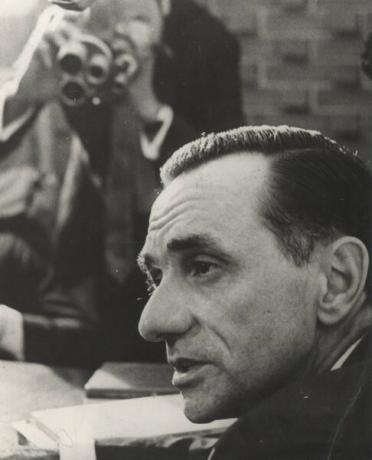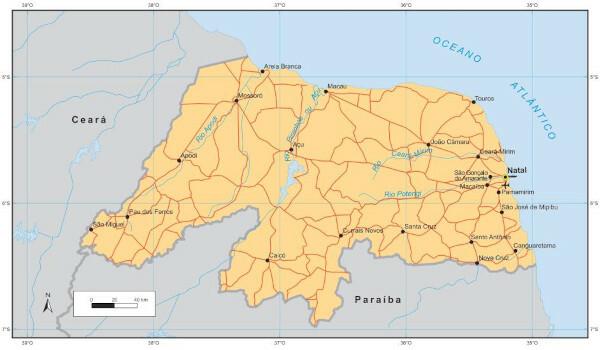Death and severe life It's a Christmas car by João Cabral de Melo Neto. And it presents verses in a larger round. This play, one of the author's most famous texts, is from 1955. And it shows the tragic existence of the migrant Severino, surrounded by poverty caused by the northeastern drought. The protagonist, in his migration process, is faced with a sad social reality and decides to kill himself.
Read too: The backlands — the drought, the backcountry and the War of Canudos portrayed in the work of Euclides da Cunha
Summary about Death and severe life
Death and severe life is a Christmas car set in northeastern villages and Recife.
The author of Death and severe life is João Cabral de Melo Neto from Pernambuco.
Death and severe life shows the journey of a migrant during the northeastern drought.
Along the way, the protagonist Severino is faced with poverty and death.
Unhappy with his reality, he thinks about killing himself, but life ends up prevailing.
The work is related to the 1945 Generation of Brazilian Modernism.
Analysis of the work Death and severe life
→ Characters of the work Death and severe life
Severino, the protagonist retreatant.
Two men carrying a deceased.
Severino Lavrador, the first deceased.
Severino, the second deceased.
Woman at the window, a prayer.
Two gravediggers.
Seu José, resident of a shack.
Two gypsies.
→ Work time Death and severe life
The playwright does not specify the time in which the events in the book occur, in order to give the work a timeless character.
→ Work space Death and severe life
The action takes place in villages from the Brazilian Northeast, covering the Zona da Mata and Recife.
→ Plot of the work Death and severe life

The story begins with the introduction of the protagonist, whose name is Severino. He is a retreatant. He is one of many Northeastern Severinos. During his migratory act, he encounters two men carrying a deceased person in a hammock. The deceased is Severino Lavrador. Afterwards, the protagonist continues his journey.
The retreating Severino intended to follow the Capibaribe River, which would guide him on his journey. Although, the river disappeared due to drought. Still, Severino continues his path through several villages in the region. He arrives at a house where another Severino's wake is taking place. Right away, Tired of walking so much, he decides to stop and look for a job.
He sees a woman in a window and asks her about a possible job. She replies that there is work, but not as a farmer, due to the drought. He then heads towards Zona da Mata, where he attends the burial of a “respectable worker”. Right away, he walks towards Recife.
In Recife, when he stops to rest, near a cemetery wall, he ends up overhearing the conversation of two gravediggers. They complain about the work and reflect on the differences between the burial of poor and rich dead. Afterwards, Severino goes to one of the docks on the Capibaribe River.
Then, Seu José, one of the residents of a shack near the river, approaches Severino. The retreatant asks the resident if the river is deep. This because Severino intends to commit suicide. Soon a woman appears and tells José that he is a father, as his son has just been born. Neighbors and friends celebrate the birth of José's son.
Other people bring gifts, nothing expensive, as they are poor. And two gypsies make predictions about the future of the newborn. Now, in the present, the child is very small, thin and pale. Finally, José, who realized Severino's disastrous intention, suggests to the retreatant that his newborn son is proof of the strength of life.
See too: Great wilderness: paths — another Brazilian novel set in the backlands
Features of the work Death and severe life
→ Structure of the work Death and severe life
Death and severe life is play, written with verses in larger round (seven poetic syllables). Furthermore, it is divided into 18 fragments, which function as scenes of the dramatic text.
→ Literary style of the work Death and severe life
The work is associated with 1945 generation of Brazilian Modernism and has the following characteristics:
formal rigor;
social realism;
sociopolitical criticism;
appreciation of popular culture.
→ Moral of the story Death and severe life
Life always wins.
Historical context of the work Death and severe life
The work Death and severe life It does not indicate when the action of the dramatic text takes place. However, the theme of the work is current today and was current in that historical context in which it was produced, that is, the first half of the 1950s. Brazil during this historical period witnessed the beginning, in 1951, of the new government of Getúlio Vargas (1882-1954).
This time, a democratic government, which was opposed by liberal groups. It was a government that believed in state intervention in the economy and the growth of state-owned companies. This generated a political crisis that led to the president's suicide in 1954. In this context, the problem of drought in the Northeast remained unresolved.
Who was João Cabral de Melo Neto, author of Death and severe life?

João Cabral de Melo Neto it is aBrazilian writer. He was born on January 9, 1920, in the city of Recife, in Pernambuco. Later, in 1940, he moved to Rio de Janeiro. In 1945, he became a diplomat, which allowed him to visit several countries around the world.
The author, elected to the Brazilian Academy of Letters in 1968, he combined his literary career with that of a diplomat. So, in 1990, he retired. However, he began to lose his vision, which prevented him from reading and writing. AND passed away on October 9, 1999, In Rio de Janeiro city.
→ Video lesson about João Cabral de Melo Neto
Image credits
[1] Alfaguara/ Companhia das Letras (reproduction)
[2] National Archive Collection/ Wikimedia Commons
Sources
ABAURRE, Maria Luiza M.; PONTARA, Marcela. Literature: times, readers and readings. 3. ed. São Paulo: Moderna, 2015.
BRAZILIAN ACADEMY OF LETTERS. João Cabral de Melo Neto: biography. Available in: https://www.academia.org.br/academicos/joao-cabral-de-melo-neto/biografia.
GODOY, Arnaldo Sampaio de Moraes. Law and literature: the poet João Cabral de Melo Neto at the Federal Supreme Court. Jus Navigandi Magazine, Teresina, year 12, n. 1,465, Jul. 2007.
MELO NETO, João Cabral de. Death and severe life: car from Natal in Pernambuco. Rio de Janeiro: Alfaguara, 2016.
Source: Brazil School - https://brasilescola.uol.com.br/literatura/morte-e-vida-severina.htm


